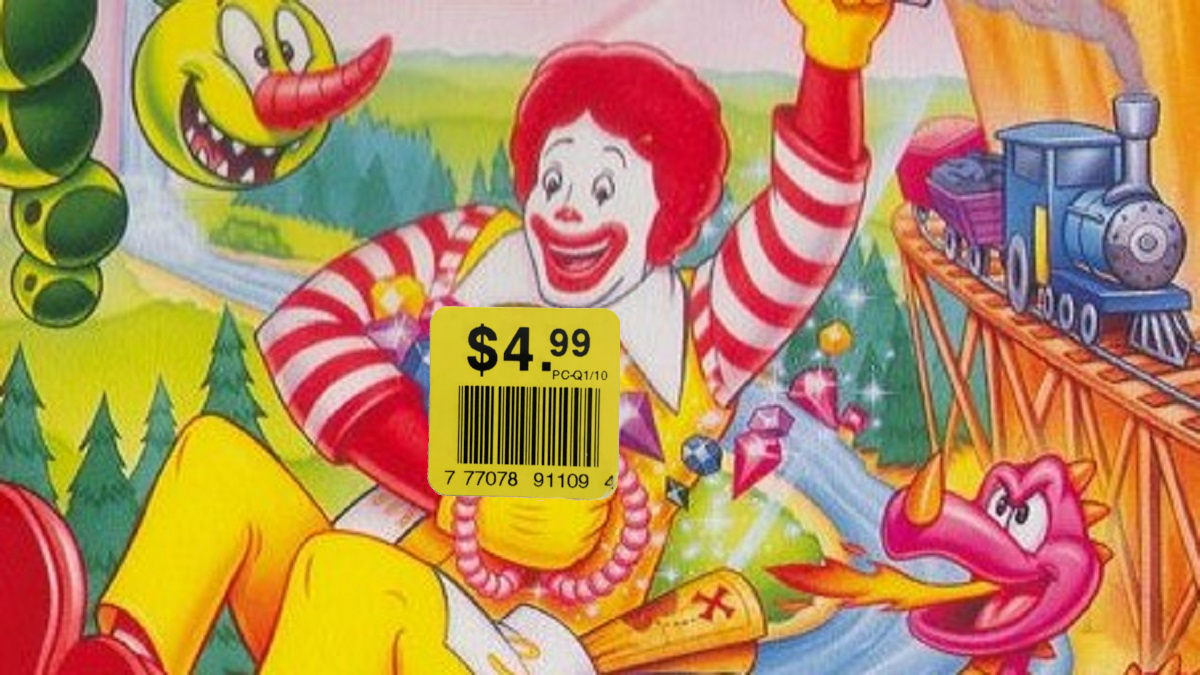Combo Number 5
McDonald’s is allegedly food. My tastebuds and my brain have a disagreement on this. My brain says that it both definitely is food, and it’s rad as heck. Meanwhile, my tastebuds say that while the brain thinks it’s being fed beef or chicken, whatever I’m running across them most certainly tastes nothing like those things. Delicious, maybe, like eating a stick of salted butter. However, no animal on earth is capable of producing such an enigmatic sensory blob of flavors.
Meanwhile, my stomach just keeps churning away at whatever I drop in there. It’s such a little trooper.
McDonald’s Treasure Land Adventure was a 1993 Sega Genesis game that is allegedly based on the McDonald’s brand. It is such a strange game and is just made stranger by the implication that it’s even adjacently related to alleged food. However, it was created by mythical developers Treasure, who also created Gunstar Heroes. That connection elevates what would normally just be an advergame into the realm of morbid curiosity.
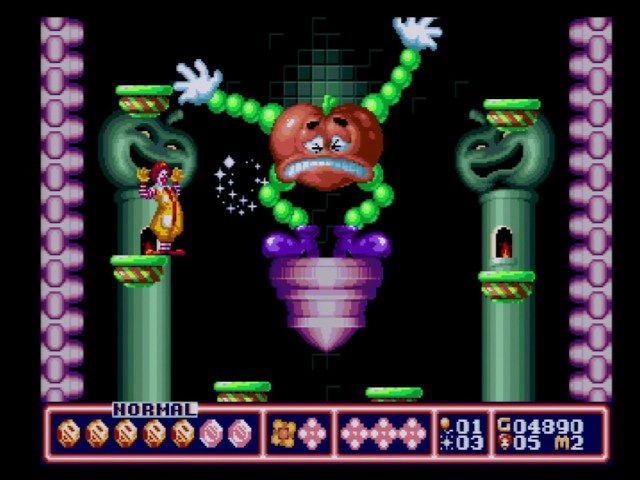
Seagulls and children
There’s been a few games based on the McDonald’s property over the years, and most of them have nothing to do with food.
Sometimes, they star the corporate pushers, but rarely a hamburger. They all stink like some executive saw three ghosts one night. The ghost of fast food future told them that they’d one day be singled out as a major cause of a future obesity epidemic and that maybe they should stop targeting children for lifetime memberships. So, this executive tore into all the developers’ offices and said, “You know what? Let’s not make these games about eating delicious burgers. What about, I don’t know, gems instead?”
As a result, you play as Ronald McDonald, the world’s palest Scotsman, but there is absolutely no food anywhere in sight. If I was designing a game based on a fast food chain, food would be everywhere. The levels would look like Level Ate in Earthworm Jim 2, and would just be platforms made out of various food groups. Power-ups and health would be meal combos from the restaurants. The enemies would be bad things that eat food, like seagulls and children. There is absolutely none of that in McDonald’s Treasure Land Adventure. None.
Chex Quest was a game about blasting snot, and even they managed to fit a perfectly balanced breakfast in there somewhere.
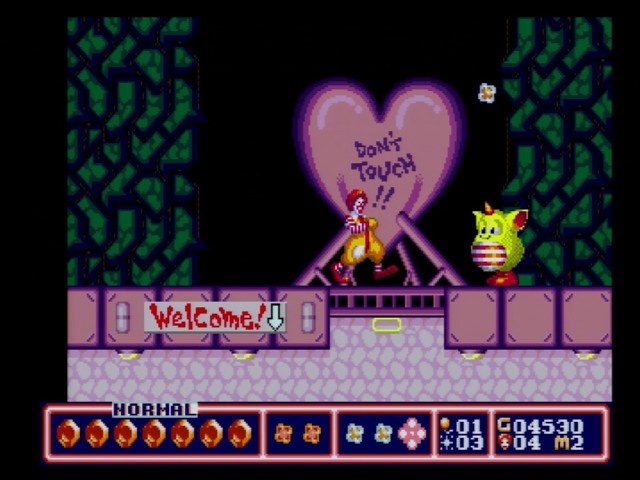
An adventure
The narrative has Ronald McDonald finding exactly one-quarter of a treasure map. He then decides to find the other pieces because adventures are fun. However, he didn’t consider that other people might already own the other pieces of the map, and he doesn’t care either. Like any good corporate mascot, something like property isn’t going to get in the way of sweet lucre, so he decides to physically assault and forcibly take the other parts of the map.
In most parts of the world, this is called “mugging.” In McDonaldLand, this is called “an adventure.”
On the surface, McDonald’s Treasure Land Adventure is a straightforward platformer. While most know Treasure for its rampant creativity, it’s clear that this is a licensed game first. 1993 was the first year of Treasure releases, and it came out extremely close to Gunstar Heroes. Maybe they knew they needed to take opportunities like these to keep the lights on while pursuing cooler projects.
Essentially, you run and jump across various worlds. Ronald can shoot sparkles at enemies and grapple with things with his scarf. That’s pretty much it. You collect power-ups in the environment to extend your life gauge and increase your attack strength, but that’s about it. However, that’s not to say that everything is normal in McDonald’s Treasure Land Adventure. It’s not completely lacking in Treasure’s usual flair.
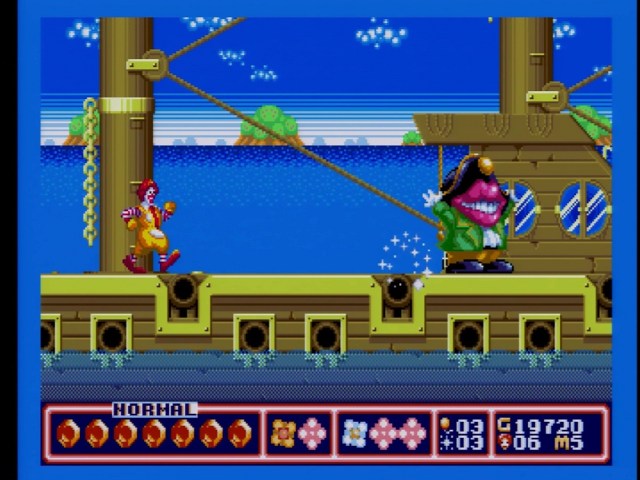
Gems and burgers
The levels you journey through are an extremely weird depiction of McDonaldLand. Not that it was ever normal to begin with. Here, however, we see things like pirate ships, trains, and earthquake-ravaged cities with human remains buried in their streets. Each area in McDonald’s Treasure Land Adventure consists of extremely brief levels that build up into bigger worlds, and the variety of enemies and obstacles is just bizarre. If the gameplay phoned in sick, the actual level design is picking up the slack.
The bosses are all pretty straightforward, but they’re just as strange. The first one is a giant tomato, which is one of the few instances of food you see in the game. The second stars a lizard fused with a jet. Each of these abominations can only be weakened by allowing them to suck the life out of you. Once they’re crunching on a gem, you can hurt them, which is an extremely strange tradeoff. I’m not sure I know of any other boss design that requires you to intentionally weaken yourself to defeat them.
The gems of your health bar are strange on their own, if only because they should be food. Enemies eat them, Ronald bribes bosses using them, and even the Hamburglar wants his fix of gems. The flowers you collect in the game were originally rings in the Japanese version, but I can’t find any evidence of the gems being actual food in previous builds.
There’s no way they couldn’t have been intended to be McDonald’s food originally, right? The developers wouldn’t have incorporated a sought after item that enemies eat and not thought of making them fries, right? I can’t get over it. That might be the strangest part of the whole experience.
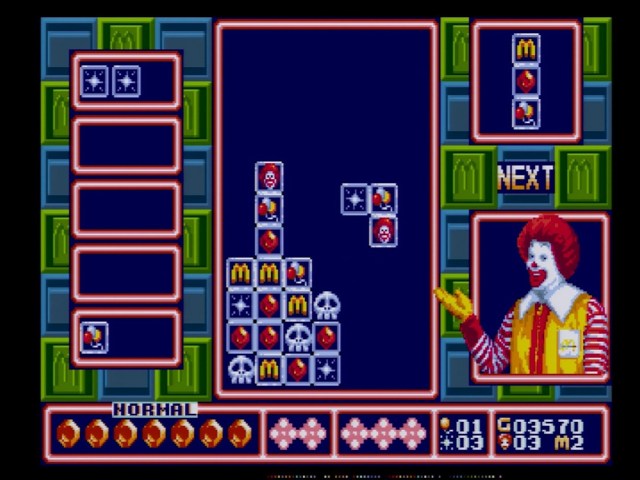
Uncomfortably tasty
There’s also this falling-block puzzle minigame that you play to win more continues and lives. I was either just extremely good at it, or it’s extraordinarily easy. I finished McDonald’s Treasure Land Adventure with an overwhelming glut of lives and continues. This was on Normal difficulty, I should add. The game defaults to “beginner,” but there are three levels of difficulty.
McDonald’s Treasure Land Adventure isn’t a terrible game, but it isn’t Treasure at its very best. However, while it’s extremely obvious that this isn’t a passion project for them, it’s obvious that they didn’t half-ass it. The gameplay might be about what you’d expect from a title based on junk food mascots, but the design has a lot of talent behind it.
If you ever wanted to see what a great developer can do with a bad license, McDonald’s Treasure Land Adventure is one way to do it. It’s not exactly a must-play game – it can die in the obscurity it lives in for all I care – but it is an absolutely strange one. I wish I was a fly on the wall during development, since it reeks of earnest design being overshadowed by corporate oversight. Yet despite that, you can still sense that Treasure had fun with it. Despite the dearth of direct connections, McDonald’s Treasure Land Adventure captures the essence of the chain’s food: nutrient-devoid, uncomfortably tasty, and existentially disturbing.


